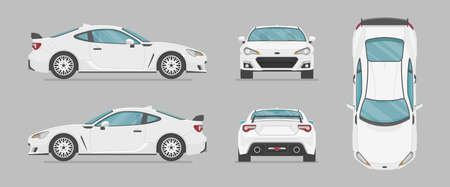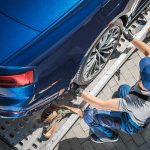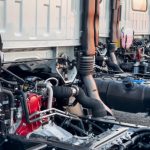1. Inspect and Maintain Your Engine
Ensure your engine is in good health by checking for leaks, worn-out components, and fluid levels before heading to the dyno. A well-maintained engine will not only perform better during tuning but also prevent potential issues that could interfere with accurate results.
Check for Leaks
Inspect your engine bay and undercarriage for any signs of oil, coolant, or fuel leaks. Leaks can affect engine performance, create safety hazards, and even cause your dyno session to be cut short. If you find any leaks, address them before your appointment.
Inspect Worn-Out Components
Look for any worn-out parts that may impact engine performance, such as cracked belts, aging hoses, or damaged gaskets. Replacing failing components ahead of time can prevent unexpected failures during tuning.
Common Components to Inspect
| Component | Signs of Wear |
|---|---|
| Belts | Cracks, fraying, or excessive slack |
| Hoses | Bulging, cracking, or leaks |
| Gaskets | Oil or coolant seeping around edges |
| Ignition System | Worn-out spark plugs, weak coils, or misfires |
Check Fluid Levels
Make sure all vital fluids are at proper levels and in good condition. If any fluids are old or low, replacing or topping them off will help maintain engine efficiency on the dyno.
Fluids to Inspect
- Engine Oil: Check level and condition; replace if old or dirty.
- Coolant: Ensure proper level to prevent overheating.
- Transmission Fluid: Verify condition and top off if necessary.
- Brake Fluid: Check level and replace if its too old.
- Power Steering Fluid: Ensure proper level for smooth steering response.
Final Inspection
Once youve checked for leaks, worn-out parts, and fluid levels, start your engine and listen for any unusual noises, hesitation, or misfires. A smooth-running engine is essential for accurate dyno tuning results.
2. Verify Fuel System and Quality
Before taking your car to the dyno, its crucial to ensure that your fuel system is in top condition. Using the right fuel type and confirming that all components, including the fuel injectors and pump, are functioning correctly will help achieve the most accurate tuning results.
Use the Correct Fuel Type
Make sure you are using the proper fuel for your setup. Different tuning requirements may call for different fuel octanes or even alternative fuels such as E85. Check with your tuner to confirm the best fuel type for your setup before you arrive.
Inspect Fuel Injectors and Pump
A failing fuel pump or clogged injectors can lead to inconsistent fuel delivery, which will affect your dyno results. Inspect these components to verify they’re functioning correctly:
| Component | What to Check | Why It Matters |
|---|---|---|
| Fuel Pump | Check for proper operation and ensure it can maintain the required fuel pressure. | Ensures adequate fuel delivery to prevent running lean under load. |
| Fuel Injectors | Inspect for clogs and verify that they are flowing correctly. | Prevents uneven fueling and ensures accurate tuning adjustments. |
| Fuel Filter | Replace if its old or clogged to maintain proper fuel flow. | Prevents debris from reaching the injectors and affecting performance. |
Check Fuel Pressure
Proper fuel pressure is essential for accurate tuning. Use a fuel pressure gauge to verify that your system maintains the recommended pressure under load. If your pressure fluctuates or drops, you may need to replace the regulator or upgrade your fuel system components.
Fill Up with Fresh Fuel
Old fuel can degrade over time, leading to poor combustion and less accurate tuning results. Before your dyno session, fill up with fresh fuel from a trusted station to ensure consistency during your runs.
Avoid Last-Minute Fuel Changes
Switching fuel types right before a dyno tune can affect performance and require additional time for adjustments. Stick to the same fuel you plan to use after tuning to ensure reliable results.

3. Check Tires, Brakes, and Drivetrain Components
Before putting your car on the dyno, its crucial to inspect your tires, brakes, and drivetrain components. A dyno session puts significant stress on your vehicle, and any weak points in these critical systems can lead to safety hazards or inaccurate readings.
Check Your Tires
Your tires play a vital role in how your car performs on the dyno. Worn or improperly inflated tires can affect traction and create inconsistent results. Follow these steps to ensure your tires are ready:
- Inspect the tread depth and look for signs of uneven wear or damage.
- Ensure your tires are properly inflated to the manufacturers recommended PSI.
- Check for any cracks or bulges on the sidewall that could indicate structural weakness.
- Consider using performance tires if your current ones are not in good condition.
Inspect the Brakes
Even though your car won’t be moving on the road, functioning brakes are still essential during a dyno session to help safely stop the vehicle when needed.
- Check the brake pads for excessive wear—replace them if they are too thin.
- Inspect the rotors for cracks, deep grooves, or warping.
- Test the brake fluid level and top it off if necessary.
- Look for any leaks in the brake lines that could compromise braking performance.
Examine the Drivetrain Components
Your drivetrain transfers power from the engine to the wheels, so any weak or faulty components can cause performance issues or even failure during the dyno test. Here’s what to check:
- Axles and CV Joints: Inspect for cracks, leaks, or excessive play.
- Driveshaft: Ensure it is properly balanced and free of cracks or abnormal wear.
- Transmission and Differential: Check fluid levels and look for any leaks.
- U-joints and Mounts: Make sure they are intact and not excessively worn.
Quick Diagnostic Table
| Component | What to Check | Actions to Take |
|---|---|---|
| Tires | Tread depth, inflation, damage | Replace or inflate properly |
| Brakes | Pad wear, rotor condition, fluid level | Replace pads, check fluid, inspect rotors |
| Axles & CV Joints | Leaks, cracks, excessive play | Repair or replace if damaged |
| Driveshaft | Balance, wear, cracks | Ensure alignment and replace if needed |
| Transmission & Differential | Fluid level, leaks | Top off fluids, fix leaks |
By taking the time to inspect and address any potential issues with your tires, brakes, and drivetrain, you can ensure a smoother and safer dyno session, allowing you to collect accurate and reliable performance data.
4. Prepare ECU and Tune Setup
Ensuring your ECU is ready for tuning is a crucial step in preparing your car for a dyno tune. A properly set up ECU allows for smooth adjustments and accurate calibration, helping you get the most out of your session.
Check ECU Compatibility
Before heading to the dyno, verify that your ECU supports tuning. Some factory ECUs may require modifications or aftermarket tuning solutions for full adjustability.
Remove Unnecessary Limiters
Many stock ECUs have built-in limiters that may restrict power adjustments. These can include:
| Limiter Type | Effect | Action |
|---|---|---|
| Rev Limiter | Prevents engine from exceeding a set RPM | Adjust or remove if necessary |
| Speed Limiter | Caps the maximum vehicle speed | Disable for accurate readings |
| Throttle Limit | Restricts electronic throttle input | Modify for full throttle control |
Install Tuning Software
Make sure you have the appropriate tuning software installed. Whether youre using an OEM reflash tool or a standalone ECU management system, ensure everything is set up for seamless adjustments.
Common Tuning Software
- Hondata (For Honda applications)
- COBB Accessport (For Subaru, Ford, and more)
- HP Tuners (For GM, Ford, and various platforms)
- ECU Master (For standalone applications)
Backup Your Existing Tune
Before making any changes, save a backup of your current tune file. This will allow you to revert to a safe setup if needed.
Verify Communication with Dyno
Ensure that your tuning device or ECU can communicate with the dyno system. Many dynos interface with tuning software for real-time adjustments, so having the right connectivity is essential.
5. Five: Secure Loose Parts and Remove Excess Weight
Before you put your car on the dyno, it’s crucial to make sure there are no loose parts and that you’ve removed any unnecessary weight. This will not only ensure accurate results but also help prevent potential safety hazards.
Remove Unnecessary Items
Dynamometer (dyno) tuning requires consistency for the most accurate readings. Extra weight from personal belongings can affect your car’s performance slightly. Make sure to remove the following:
| Items to Remove | Reason |
|---|---|
| Loose tools, spare parts | Prevents them from moving around and causing distractions |
| Floor mats, unnecessary cargo | Reduces unnecessary weight |
| Personal belongings | Keeps the interior organized and free of hazards |
Secure Loose Components
Any loose or rattling components can be a safety concern during a dyno session. Vibrations from high RPM runs may cause unsecured parts to come loose or create inaccurate readings. Here’s a checklist of what you should check:
- Battery – Ensure the battery is properly secured in its tray.
- Hoses and wiring – Verify that fuel lines, vacuum hoses, and electrical connectors are tight.
- Body panels and aero parts – Check for loose bumpers, side skirts, or wings that could detach.
- Exhaust system – Inspect exhaust clamps and mounts to prevent excessive movement.
Eliminate Potential Safety Hazards
To keep everyone safe during the dyno session, ensure your vehicle is free from potential risks. Double-check fluid leaks such as oil, coolant, or fuel, as leaks can pose fire hazards. Make sure your tires are in good condition and properly inflated to handle the high-speed runs. Lastly, remove any items from the interior that could fly around when the car is being tested.
Final Check
Once you’ve secured everything and removed unnecessary weight, do a final walk-around of your car. Give everything a quick shake to make sure nothing is loose, and you’re all set for a safe and effective dyno tune.


